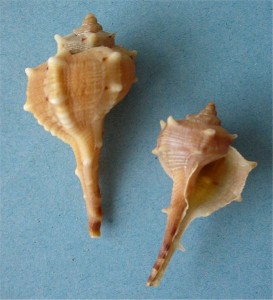http://youtu.be/_x6D3ABeBcY
1. Not everyone wore togas. Only free-born men were allowed to wear togas (as a sign of citizenship), while women wore stolas. Prostitutes and adulterers wore togas, because they were not allowed to wear stolas and this male garment was a sign of their female disgrace and shame. This is even reminiscent of Hawthorne’s Scarlett Letter.

HBO’s Rome Series
2. Hair dying was popular among women. Red and blonde were the most popular colors. Dye colors were achieved through ingredients like goat fat, beech wood ashes, henna, saffron, and bleach. Even modern day women dye their different colors to achieve a new look. There is even a popular scene in Rome, where Atia is choosing amongst her dyed wigs (only the extremely wealthy had wigs) of blonde, red, orange and even blue. Henna was used by the Egyptians in 1500 B.C.E. More on hair dying and other cosmetics can be found here.

Spiny dye-murex
3. Purple clothing was a high status symbol; reserved only for emperors or senators. To achieve the color, a dye was made from murex seashells or the tyrian seashell. It was treason for anyone other than the emperor to dress completely in purple. However, it is often mistaken that it was a fine or royal purple as modern people know purple; instead the purple was closer to that of a rich maroon. The science behind the seashell dye can be discovered here.

A strigil used to collect strigmentum.
4. Gladiator sweat was used as cosmetics. The sweat of gladiators and the fat from animals use to be sold in “souvenir pots” outside the arena to improve complexion. The sweat would have been captured by means of a strigil and the oily sweaty mixture known as strigmentum would have been bottle and sold for cosmetics and even as an aphrodisiac. The notion that gladiator sweat was good for one’s complexion or even their sexuality even not a difficult conception. The virality of the gladiator continues to appeal to modern consumers as can be seen with Le Male Gladiator Jean Paul Gaultier. The BBC has an amazing website that discusses this at length; here.

Bronze Phallic Wind chime( tintinabulum).
5. Phalluses were worn on necklaces and considered good luck charms. They were worn as charms on necklaces or hung in doorways as wind chimes as a way to ward off evil spirits. However, this Roman “fade” may be seeing a resurgence with Ke$ha’s newest “penis” jewelry line, as can be seen here. Although, I doubt her phallic jewelry has any symbolic or magical properties other than being avant-garde to modern society’s standards.









Comments:
Matthew:
Wish I’d read this prior to Halloween, I think I’ll be dressing as a casual Roman in a tunica next year: togas are just way too formal for a party!